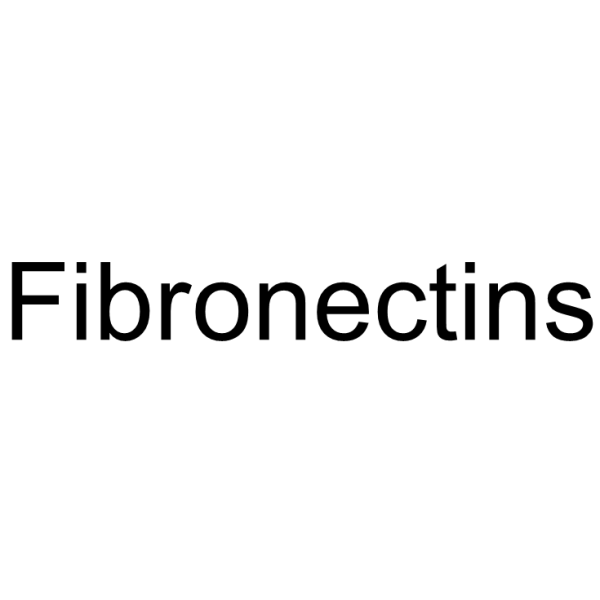Fibronectin

Fibronectin structure
|
Common Name | Fibronectin | ||
|---|---|---|---|---|
| CAS Number | 86088-83-7 | Molecular Weight | N/A | |
| Density | N/A | Boiling Point | N/A | |
| Molecular Formula | N/A | Melting Point | N/A | |
| MSDS | USA | Flash Point | N/A | |
Use of FibronectinFibronectin, a glycoprotein (~500 kDa) present in blood as well as in cells, is a biomarker of tissue injury. Fibronectin binds to membrane-spanning receptor proteins called integrins. Fibronectin also binds to other extracellular matrix proteins such as collagen, fibrin, and heparan sulfate proteoglycans[1]. |
| Name | Fibronectin from bovine plasma |
|---|---|
| Synonym | More Synonyms |
| Description | Fibronectin, a glycoprotein (~500 kDa) present in blood as well as in cells, is a biomarker of tissue injury. Fibronectin binds to membrane-spanning receptor proteins called integrins. Fibronectin also binds to other extracellular matrix proteins such as collagen, fibrin, and heparan sulfate proteoglycans[1]. |
|---|---|
| Related Catalog | |
| In Vitro | Fibronectin (FN) is a glycoprotein present in blood as well as in cells. While Fibronectin (FN) in blood has many functions, its primary role is to promote wound repair following injury. Increases in plasma Fibronectin (FN) has been reported after inflammation, trauma, and diseases such as atherosclerosis. Tobacco-related lung diseases are characterized by increased accumulation of Fibronectin (FN) which can be induced by nicotine. We found significant increases of plasma Fibronectin (FN) following exposure to e-cig aerosols and TS. Although our study examined the levels of 8-oxodG, CRP, and Fibronectin (FN), additional markers for lung injury need be explored in future studies[1]. Fibronectin also binds to other extracellular matrix proteins such as collagen, fibrin, and heparan sulfate proteoglycans (e.g. syndecans) [2]. |
| References |
[2]. Roumen Pankov, et al. Fibronectin at a glance. J Cell Sci. 2002 Oct 15;115(Pt 20):3861-3. |
| Storage condition | -20C |
|---|
| Personal Protective Equipment | Eyeshields;Gloves;type N95 (US);type P1 (EN143) respirator filter |
|---|---|
| RIDADR | NONH for all modes of transport |
|
Preclinical evaluation of cyclin dependent kinase 11 and casein kinase 2 survival kinases as RNA interference targets for triple negative breast cancer therapy.
Breast Cancer Res. 17 , 19, (2015) Targeted therapies for aggressive breast cancers like triple negative breast cancer (TNBC) are needed. The use of small interfering RNAs (siRNAs) to disable expression of survival genes provides a too... |
|
|
Endothelial cell-derived fibronectin extra domain A promotes colorectal cancer metastasis via inducing epithelial-mesenchymal transition.
Carcinogenesis 35(7) , 1661-70, (2014) Recent evidence has been suggesting the important roles of endothelial cells (ECs) involved in the pathogenesis of several cancers, including colorectal carcinomas (CRCs), but the underlying mechanism... |
|
|
Cellular fibronectin containing extra domain A promotes arterial thrombosis in mice through platelet Toll-like receptor 4.
Blood 125 , 3164-72, (2015) Cellular fibronectin containing extra domain A (Fn-EDA+), which is produced in response to tissue injury in several disease states, has prothrombotic activity and is known to interact with Toll-like-r... |
| EINECS 289-149-2 |
| MFCD00131062 |

